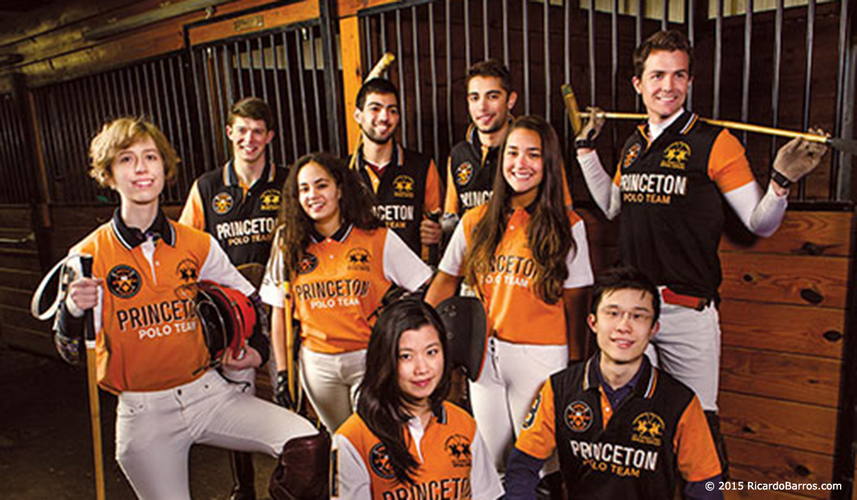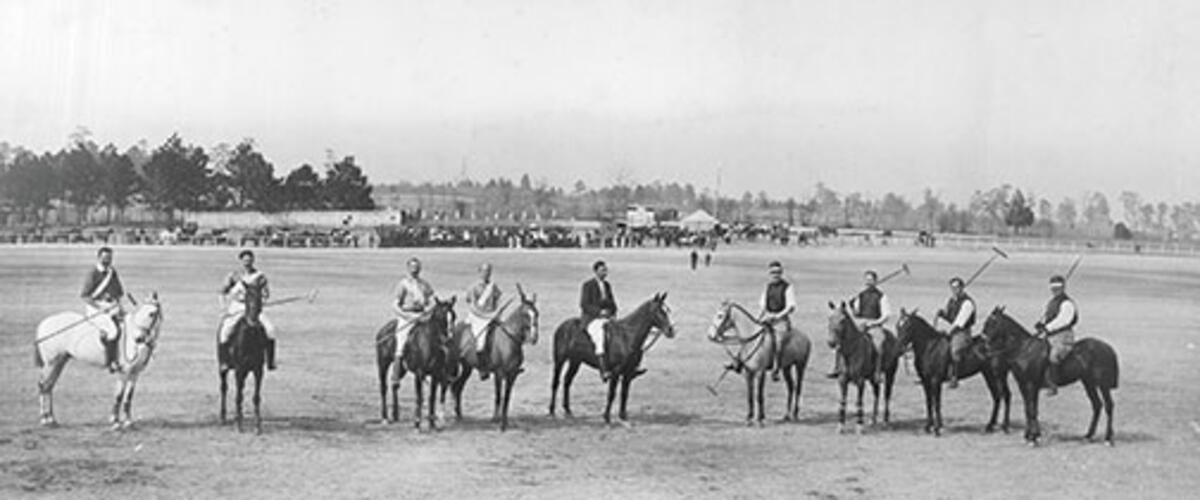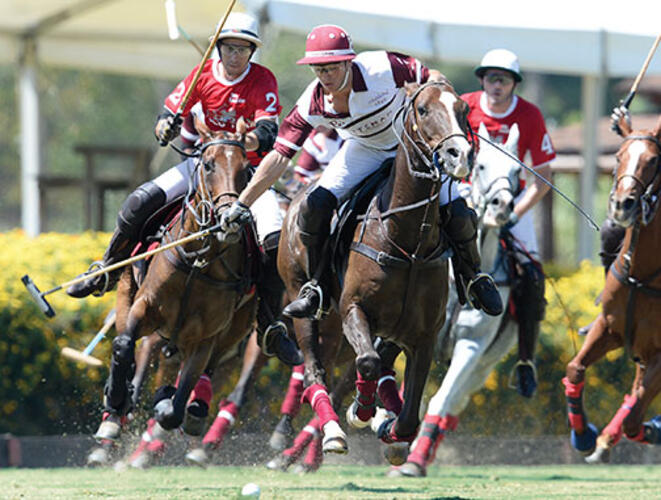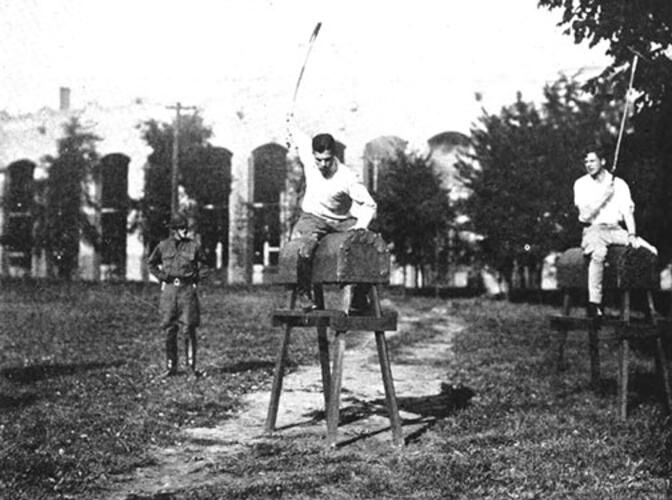
When the Princeton and Yale men’s polo teams faced each other in New Haven in February, it would have been natural to cast Princeton as the lovable underdogs: the Bad News Tigers, a plucky gang of orange-and-black longshots. But because polo is as overdog a sport as they come, there was little support for such narrative dramatics. Instead, the pre-match mood was one of self-effacing good manners. An hour before the match, Princeton’s captain, Nikolas Weissmueller, set out a box of Dunkin’ Donuts for everyone to enjoy. “The thing about polo,” he explained, “is that you have to lose like you enjoy it, and win like you don’t care.”
That’s a nice and gentlemanly attitude, the kind of thing you’d expect in a sport played by born winners. Up close, however, polo is not the glossy stuff of Ralph Lauren catalogs. There are mad dashes, snorting horses, and thrown elbows, all mixed up in a frenzied combination of horse racing, chess, and hockey.
In the plainest terms, then, and all gentlemanliness aside, did the Princeton polo team want to destroy Yale on that freezing Saturday in Connecticut? Yes, it did. Was it likely to succeed? No, it was not.
Yale’s bench of players was deep and seasoned. Its star freshman had played competitively in India before starting college. Princeton’s most experienced player was Weissmueller, a chemical engineering postdoc who had been playing for two-and-a-half years. (“On and off,” he clarifies for precision, “because I couldn’t afford to play much as a Ph.D. student in England.”)
Yale also enjoyed home-horse advantage: The game would be played using Yale’s practice mounts, which in polo are called “ponies.” This meant a familiar ride for Yale, and a fast learning curve for Princeton.
History, too, was on the Elis’ side. With 19 national championships and more than 100 years of equestrian excellence, Yale is the winningest program in U.S. college polo. Princeton hadn’t played a game of polo since 1963 — making February’s match against Yale a rebirth for the program.
If any campus should have a team, perhaps it’s Princeton. Polo is one of the world’s oldest team sports, with a millennia-long history on the plains of Asia. The history of the college game in America is much shorter — but it begins at Nassau Hall.
In 1903 a group of undergraduates banded together to play what was then known as “pony polo” (as opposed to “bicycle polo,” also in vogue at the time). The game had been brought to the United States a few decades before by British expatriates, who had adapted the game from a version played in India. In the Anglophone formulation, polo consisted of two teams of four (three in indoor polo), mounted on horses, advancing a small ball down a field using the long edge of a croquet-like mallet. Some players served primarily as attack, some as defense. The attackers’ aim was to place the ball between the opponent’s goal posts. There is no goalie except for certain penalty shots. This is still the game today, more or less.
In May 1903, Princeton and Yale played the country’s first intercollegiate polo match at Van Cortlandt Park in New York City. Led by captain Walter Devereux Jr. 1904, Princeton won, 7 goals to 2. But it was a pyrrhic victory. During the match, Devereux accidentally struck a Yale player named Henry Babcock Jr. in the head with his mallet. At the time Babcock had laughed off the injury; the next day, however, he fell unconscious and died. The Princeton team disbanded for the season soon after. “The players feel too keenly the death of Babcock to continue the game,” The New York Times reported.
The team that started up again in 1920 looked considerably different than its turn-of-the-century predecessor. For one thing, most players now wore helmets. For another, there was a new boss in charge. With the end of World War I, the U.S. Army turned to expanding its Reserve Officer Training Corps on college campuses, and polo was one of its best recruiting tools. ROTC students could gain free access to government stables and polo equipment, no experience required. The hope among the ROTC brass was that polo itself — with its emphasis on riding skills, quick reversals, and long-range assaults on goal — would serve as a kind of military tactics training.
The result was a golden age for university polo. New players and playing styles abounded. The West had the rough-and-tumble University of Arizona, described in a local paper as “hard-riding cowboys on sure-footed mustangs.” In the East, you watched out for the military schools, straight-backed squads that served as a further link to the game’s martial traditions. Among the Ivies, Yale was consistently splendid, while Princeton had a reputation for patchy brilliance.
In 1920, for instance, the revived Princeton polo team conducted most of its practices in the judging ring of the New Jersey State Fair, lost every regular-season match it played, and then — surprise! — won the sport’s year-end intercollegiate championships. By 1927, the team was 60 men strong, and a polo match on Princeton’s new Devereux Memorial Field drew more spectators than baseball over Houseparties weekend.
These were glory days. The 1930s and early 1940s brought Princeton a slew of championships — a total of six indoor and outdoor titles — under the leadership of stellar players like Leonard ’31 and Raymond ’33 Firestone (of the tire company and the library). But signs of the game’s irrelevance were growing. What use was a horse-powered war simulation in an age of heavy metal destruction? In 1937, the Princeton Field Artillery stopped using live horses in its exercises and switched to cars and other machinery. The end was nigh.
In May 1942, Princeton hosted the intercollegiate polo finals for the first and last time, beating Yale 6–4 to capture the championship. Soon after, the War Department decided it had better things to do than administer a college polo league — things like, say, send its reserve officers off to fight World War II. In the absence of eligible players, the intercollegiate polo trophy went into safekeeping in Princeton’s gymnasium; two years later, it was destroyed in a fire. After the war, when the GI Bill brought a rush of young families to Princeton, the University paved over Devereux Field to build the Butler apartments. As writer and professor John McPhee ’53 recalled in PAW, for hometown spectators this meant the end of polo — “yes, the whole chukker, students in jodhpurs, the horse latitudes.” Or, as PAW described it: “an emblem of tweedy Princeton sacrificed to the cause of mass education.”
The team was revived —twice — as a club sport in the early ’50s and ’60s, but both squads disbanded once their core players graduated. A ’60s team went 0–9 in its first full season of play (The Daily Princetonian: “Winless polo team lacks horses, fields”), but to its credit, demonstrated élan even in defeat. “Thruston Pettus [’63] hit a hard shot in the indoor arena at Cornell, and my recollection is that it broke a steam pipe,” recalls Jerold Horn ’63. “Everyone else was backing away from this explosion of the pipe. But Thruston calmly walked up to the ball and scored a goal.” Princeton lost all the same.
“It was tough. We couldn’t ever practice, we had to use the other team’s horses, and they never seemed to give us the good ones,” recalls Pettus, now a retired banker living in South Carolina. Still, he has fond memories of his time playing polo at Princeton, and he’s tickled by the thought of a reconstituted team. “I find it refreshing that in this day and age PU would actually admit someone who can ride a horse. Not exactly the politically correct image!” he writes in an email.
The legacy of Princeton polo now rests on the shoulders of Nikolas Weissmueller and his teammates. Weissmueller is a Harvard man turned unsung Princeton hero. As a Ph.D. student at Oxford, he worked on the meningitis B vaccine used at Princeton during the outbreak in 2013–14; he also got hooked on polo.
Weissmueller joined the Princeton equestrian team soon after starting his postdoc in December 2013, and almost immediately began advocating among its ranks for a polo club. Valeria Ibarcena ’17 was eager to make the switch. “The equestrian team is nice here, but it’s a little bit limited in what we can do,” she says. (There’s a lot of riding in circles around a ring.) “I wanted a bigger adrenaline rush from polo.”
By New Year’s 2014, Weissmueller had lined up a coach and sponsor: Hesham El-Gharby, a former player for the Egyptian national team. El-Gharby owns a riding arena and stable in Frenchtown, N.J., about an hour from Princeton. The team pays El-Gharby for horse, arena, and equipment rentals. El-Gharby provides coaching and hospitality gratis. “He’s incredibly nice,” Weissmueller says. “He brings cake and pizza and shrimp, and he’s just so generous.”
Since last spring, Weissmueller and his teammates — about a dozen players on men’s and women’s squads — have been practicing twice a week to prepare for the 2015 season. Riding tactically is not easy: Players must manage four reins with one hand while controlling their mallet with the other. Hitting a polo ball on the run is often compared to playing golf in an earthquake. “The most common mistake is people hit the ground [with the mallet] before they even get to the ball,” Weissmueller says of Princeton’s practices. “Actually hitting your horse in the butt is frequent, in which case it’s going to run off.”
And so it was with high hopes and low expectations that Weissmueller scheduled that February match against Yale. “I knew it would be a bloodbath,” he says. But he was faced with a Catch-22: “To be a good program, you need good players, but to get good players, you need to be a good program.” Weissmueller hopes that Princeton can emulate the polo team at his alma mater Harvard, which was revived in 2006 and since has purchased a new indoor riding hall on the strength of alumni fundraising, including contributions from the actor Tommy Lee Jones. Jones also has donated horses from his Texas ranch.
This year, Princeton’s polo dues are $1,500 per semester. Team leaders hope to lower that through fundraising. The goal is “to open up the world of polo to people who wouldn’t otherwise have access to it,” says Ibarcena, Princeton’s women’s captain. “The U.S. Polo Association says — and it’s right — that college polo is the most accessible polo that a person’s going to see throughout their lifetime.”
Unable because of a lack of money to participate in intercollegiate league play, Princeton instead is playing “friendlies” at colleges where it can borrow horses and equipment. Matches at Harvard and Brown were set for April; a women’s match at Yale was being planned.
The men’s Yale match in February stood out as a chance for a splashy victory — a calling card for alumni and recruits. The only problem would be actually winning against the experienced Yale squad. As they say in sports movies — the kind they don’t make about sports like polo — Princeton needed a miracle.
The miracle’s name, as it turned out, was Dillon Bacon. Early in the week of the Yale-Princeton polo match, Bacon received an email from Weissmueller. “I said, ‘Hey, where are you — if you’re around when we’re playing Yale, are you interested?’” Weissmueller recalls.
Bacon was not around: He was in Buenos Aires, where he was working at a small financial firm. But as luck had it, his flight from the United States to Argentina originally had included a return leg back to New York, which he had decided not to use. Now he figured, “Screw it! I would love to support the Princeton polo team.” He quickly threw together a trip to New York.
Here is what I learned about Dillon Bacon over the course of two drives between the Upper East Side of Manhattan and Yale’s Riding Hall in Bethany, Conn.: His hair is medium-length and impeccable; he prefers house music but will let you choose other songs if you’re sharing a car. He holds two passports, American and British; he has great taste in neutral-colored separates. He thinks the eating-club system segregates people too much; like many of his British-schooled contemporaries, he is a member of Ivy Club. Most importantly, while Bacon walked at graduation with the Class of 2014, as of February 2015 he had not yet fulfilled Princeton’s language requirement — which for the purposes of the “friendly” made him eligible to play for the Princeton men’s polo team. (The same ad hoc rules for friendlies meant that Weissmueller, a postdoc, could play.)
I learned, furthermore, that Bacon is a very good polo player. He started playing when he was about 12 years old at boarding school in England. In Spain he has an official handicap of two out of 10 (10 being god-tier, two being on the line between semi-pro and serious amateur). Last summer his squad won three tournaments at the Andalusian polo mecca of Sotogrande — and modeled for its sponsor, the Savile Row tailor Huntsman.
The Yale players weren’t expecting to see Bacon at the match, but the British among them recognized him. “You’re serious?” one asked with feigned (or real) dismay. Bacon repeated his story: unfinished language requirement, in town for a long weekend, couldn’t miss the return of Princeton polo.
The day before the match, he had drilled the squad and helped to devise Princeton’s strategy: Overpower the Yale players, clear a path, and get him the ball whenever possible. “We went from medium-speed to fast-paced just by having him there,” Weissmueller says. “He’s a really chill, nice guy, but on the polo field he’s ferocious.”
At 200 by 80 feet, the indoor field at Yale was smaller than standard regulation size. This would make for a tight, physical match. Indoor arena polo is divided into four seven-minute chukkers (i.e. periods, from the Sanskrit cakra, meaning “wheel”). Teams switch off horses every chukker to keep their rides sprightly. As an arena game, the match was three on three, plus a referee in the ring to call fouls — of which there were many.
“All the penalties are designed for the safety of the horse,” Yale’s announcer informed the assembled crowd of 30 friends and parents at the start of the first chukker. Chief among these fouls is a violation called “crossing,” which occurs when a player strays in front of the ball’s projected line of motion. This leaves players with a few defensive options. They can force opponents off the path of the ball by pressuring them from the side (sometimes through vigorous saddle-to-saddle elbowing). Or they can try to hook their rival’s mallet with their own to interrupt the opponent’s shot.
“In arena polo, people tend to win based on penalty shots,” the announcer continued, a prediction that largely proved true. From time to time, however, there were flashes of grace. Midway through the first chukker, with Princeton leading 3–1, Bacon broke away from a scrum near Princeton’s end of the arena and cantered toward the other side. He wasn’t simply thwacking the ball toward the goal, as most other players did during the match; he was dribbling, pushing the ball only as far as he needed to set up another advancing swing. At 15 feet out, with a languid stroke and a boom, he guided the ball into the center of the goal.
Even the Yale crowd broke out in spontaneous applause. At the college level, polo can present as an unwieldy negotiation among man, mallet, and horse. Bacon had produced a higher kinetic harmony. I recalled a compliment I’d read in an article about polo from the 1920s: “He rode like a centaur.”
“He’s a standout,” one woman said from her perch in an elevated viewing box.
“I hear he already graduated,” her friend replied.
“Technically not!” I chirped.
A few seconds later, Bacon took another foul shot for the Princeton team.
“Why is Dillon always hitting?”
“Because he’s the best.”
“Because he’s a ringer.”
Yale soon tried to triple-team Bacon, but Weissmueller and teammate Alex Sen ’16 worked to separate two of Yale’s defenders from the action. Bacon scored five times in the period, putting Princeton up 5 to 3.
In the second chukker, disaster. After switching ponies, Bacon landed on an ornery horse named Picasa. His difficulty in steering her limited Princeton to two goals. At one point Picasa threw Bacon from his saddle. (“Just get off the horse, any way you can!” Bacon says later. “You really don’t want to get caught in the stirrup.”) Yale took advantage of the tumult to go up 8–7; the audience took advantage of the frequent play stoppages to swap stories about the expat set: Who had just broken up with whom, who was flunking out of Harvard, who had pledged what frat, which this crowd pronounced “frot.”
Back on the field, the pressure mounted throughout the third chukker. “You gotta get my back!” Bacon instructed his teammates. The referee threw in the ball; Bacon intercepted it straight away and dribbled toward the right corner wall of the arena. This was faultless tactical play, and he tapped the ball in with ease. By the end of the chukker, the score was 13–11 in Princeton’s favor, and the horses steamed with sweat.
Princeton’s strategy for the fourth chukker was to play clean and slow, and preserve the lead by not fouling. In this the team largely failed, notching as many fouls in the final quarter (14) as in the other three combined. Fortunately, Yale performed even worse. At the end, Yale’s announcer provided the score with a minimum of ceremony: Princeton 17, Yale 14.
Both teams then retired to the equipment room for a celebratory meal of bottled water and pepperoni pizza. True to gentlemanly form, the losers seemed happy enough, while the winners projected an air of caring a little but not too much. The pizza was fresh, and the air smelled like sawdust and manure. From its perch on a shelf by the wall, a small plaque offered reassurance to all the lucky athletes assembled: “Polo brings courage, confidence, and joy.”
David Walter ’11 is a journalist in New York City.










6 Responses
Edgar “Ted” J. Mack ’55
9 Years AgoPolo, Horses, and a Soldier’s Story
Published online January 4, 2017
In regards to the April 22, 2015, cover article, “Ride Like a Centaur, Win Like a Tiger”:
My father, Edgar “Buddy” Mack Jr. ’31, from an early age was enthralled by horses. In applying for college, when he heard Princeton’s ROTC unit was field artillery with its horse-drawn equipment … that was the college for him!
He joined ROTC as a freshman in 1927 and discovered not only horses but a polo team! And polo became his extracurricular focus for the next four years. Buddy worked hard at learning the game from his Army taskmasters, veterans of the Great War. In fact, that is my father practicing his swing on a wooden horse in the photo on page 27!
The rest of the story: After graduating, Buddy returned home to Cincinnati and joined the Army Reserve because Cincinnati had a remount unit. Then, when reserve officers were called up in September 1940, he was assigned to a quartermaster unit at Fort Thomas, Ky. The Army in 1940 was still purchasing saddles, bridles, and horse feed. The base commander was desperate to find an officer who knew something about horses. My father was his man. His Princeton education came to great use!
Fifteen months later we were at war. He was transferred to the Army Air Corps — no more horses, he thought.
However, in early 1943 Buddy was assigned to central Missouri where a glider-training base was to be built from scratch, turning open land, woods, and farms into an airfield. Not nearly enough bulldozers and heavy equipment were available, so my father and a base C.O. (a World War I cavalry officer) came up with the plan of enlisting local farmers with their mule teams to help clear and grade.
The colonel and Lt. Mack requisitioned remount horses so they could supervise construction from the proper perspective. As a result, the Knobnoster Missouri Army Air Base (Gilder Training Command) was constructed on time (almost). The planes took to the sky, and the farmers and mules returned home. Job well done!
Robert Jiranek ’52
9 Years AgoLinking Polo With Service
As Princeton looks again at fielding a team for polo (cover story, April 22), the sport of kings, it should be seen in part through a prism of community service. Harvard, Yale, Cornell, Stanford, and other prestigious educational institutions have a community focus for their polo clubs.
Secondary-school students from disadvantaged backgrounds can learn to play polo. A horse in a teamwork-oriented, competitive environment is not concerned with ethnicity. Excellence is the result of hard work, control, and understanding.
In Southside Virginia we have established the nonprofit corporation EQUS Inc. to work with secondary-school children, teaching polo. EQUS would like nothing better than to become the “Blairstown” in southern Virginia for the Princeton polo club and team.
Braxton Mitchell ’50
9 Years AgoResurrecting Polo
When I was a freshman, I heard that a polo team was being organized. So I went to the meeting and was asked, “How many ponies do you have?” That ended my career in polo.
Richard Jackson ’62
9 Years AgoResurrecting Polo
Congratulations to PAW for your excellent article, “Polo Returns to Princeton.” I thought that it might be worth highlighting the glorious 1924 Princeton polo team, which won both the Eastern and the National Intercollegiate Polo championships and is described in Horace A. Laffaye’s Polo in the United States: A History. The team, which was national runner-up the previous year, consisted of Princeton seniors and was coached by Capt. J.W. Andrews. Facing the heavily favored University of Arizona, Princeton handily swept the first two games, locking up the National Intercollegiate Trophy.
Left to right in the team photo above are David Holbrook, Charles Newbold, William H. Jackson (captain), and Thomas Bancroft. Full disclosure: William H. Jackson, who died in 1971, had two sons at Princeton, William H. Jackson ’54 and me.
Bryan Jones ’53
9 Years AgoResurrecting Polo
Kudos to David Walter ’11 for his fine polo piece (cover story, April 22). His admixture of a century of obscure Ivy League polo facts, woven into Princeton’s recent and surprising (to me) readoption of the sport, is adept, informing, and entertaining.
Virginia H. Bennett *71
9 Years AgoResurrecting Polo
As a horsewoman in my childhood and teens, I greatly enjoyed participating or watching (as in the case of polo) many “horse-based” sports, so I was delighted to learn that Princeton had “resurrected” polo. I hope this time around it thrives and keeps on going!